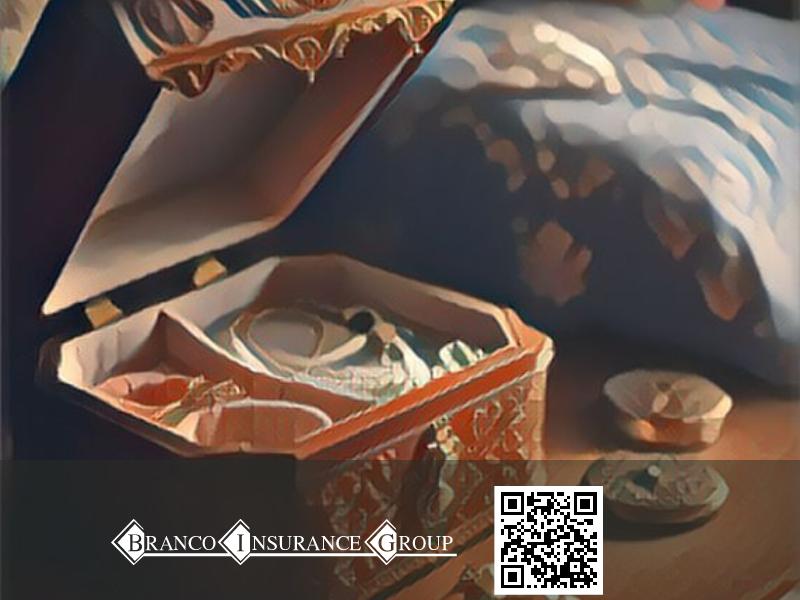
Mental Health Awareness Month: Prioritize the Mind, Support the Heart
May is Mental Health Awareness Month, a time to reflect on the importance of emotional well-being and the invisible battles many face daily. At Branco

Life can be unpredictable, like a rolling stone that travels from place to place. One moment you could have everything in the world, and then something happens, and it all goes away instantly. That’s why Scheduled Personal Property Coverage is so important. It helps protect your possessions no matter where life takes you.
Scheduled Personal Property Coverage provides protection against unforeseen events such as theft or damage due to fire or other natural disasters. It ensures that even if the worst should happen, you can rest assured that at least some of your most prized possessions will be covered financially. Whether you own expensive jewelry, artwork, technology devices, or collectibles – this coverage is designed to provide peace of mind for any situation.
For those who live an adventurous lifestyle with ever-changing circumstances, Scheduled Personal Property Coverage offers financial security when it matters most. With its help, you don’t have to worry about losing out on valuable items – now you can relax knowing your belongings are protected.
Is standard personal property insurance enough? It often depends on the situation. Standard personal property coverage typically includes fire, theft, and vandalism, but not all losses are covered by this type of policy. For instance, if a valuable item such as jewelry or artwork is lost or damaged in the event that it isn’t covered, there may be no way to recover it through a standard homeowner’s insurance policy. That’s why scheduled personal property can help provide additional protection for high-value items. Without it, you could face substantial financial loss due to uninsured events. Transitioning into how scheduled personal property can help, one must first understand what it is and how it works.
Scheduled personal property coverage offers protection specifically tailored to items with high value, such as jewelry, artwork, antiques, and collectibles. It provides higher limits than most home policies in order to cover these valuable items in case they are lost, stolen, or damaged. The policy also covers the cost of repair or replacement without any depreciation taken out of the payout amount. This type of coverage is especially important if you own expensive pieces that would be difficult or impossible to replace at their full worth.
It’s easy to see why scheduled personal property could offer peace of mind and assurance against unforeseen circumstances. With this added level of security, you don’t need to worry about losing out on money due to depreciated values after damage or theft occurs.
So now comes the question: What is unscheduled personal property?
Unscheduled personal property is any item of value that isn’t specifically listed in your homeowner’s insurance policy. This includes valuable items such as jewelry, collectibles, and firearms. It also covers the costs associated with replacing these items if they are damaged or stolen. To protect yourself from a financial loss due to an uninsured item, it’s important to understand how unscheduled personal property coverage works.
With this type of coverage, you can add certain valuables to your policy for a specified amount up to a predetermined limit. Depending on the insurer and policy limits, different types of goods may be covered under unscheduled personal property coverage. However, most policies include common items like antiques, electronics, and artwork without requiring additional documentation or appraisals.
When determining whether you should purchase additional coverage for an expensive item, consider its age and condition. If it has been recently purchased or was made within the last few years, then scheduling it on your existing insurance policy might make more sense than purchasing separate insurance for it. Having all of your valuable possessions protected by one policy ensures that you’re fully covered in case something happens to them unexpectedly. From here, we will explore the benefits of scheduling valuables onto your homeowner’s insurance policy.

It’s ironic that so many of us take great care to insure our homes, cars, and other possessions without giving much thought to what happens if a disaster or theft strikes. Without proper coverage in place, the financial consequences could be disastrous. Scheduling personal property is an important way for homeowners to protect themselves from these risks.
Scheduled personal property coverage provides protection against losses caused by perils like fire, windstorm, hail, and vandalism, all of which are typically covered under most homeowner policies. It also covers loss due to theft or mysterious disappearance. This means that even if you can’t prove how something was stolen or lost, you may still be able to recover some compensation through your insurance policy.
Additionally, scheduled personal property coverage allows you to list specific items on your policy and provide additional coverage for them beyond the limits of your standard homeowner’s policy. This includes expensive jewelry, artwork, and antiques, valuable items which might not otherwise be adequately protected with traditional home insurance policies. With this extra layer of protection provided by scheduled personal property coverage, you can rest assured knowing that your valuables will be taken care of should the worst happen.
With all its benefits, it’s clear why scheduling personal property is such an important part of protecting one’s assets. But what exactly is the difference between unscheduled and scheduled personal property? That distinction will be discussed in the next section.
Unscheduled personal property coverage is insurance that generally applies to a broad range of items in your home, such as furniture, clothing, jewelry, and electronics. It covers these things in the event they are stolen or damaged by any peril except those listed in the policy exclusions.
Scheduled personal property coverage provides more specific protection for certain valuable items that may require special attention due to their high value. Examples include antiques, collectibles, artwork, and guns. This type of coverage offers higher limits than unscheduled personal property coverage and often requires an appraisal from an expert to determine the current market value when filing a claim.
Scheduled personal property also typically includes additional perils not covered under unscheduled personal property policies, such as breakage, mysterious disappearance, and mechanical breakdowns. So it’s important to consider if you have expensive items like jewelry or artwork that need extra protection from damage other than theft or vandalism. With this knowledge, you can decide which type of coverage best fits your needs for protecting your possessions.
Believe it or not, unscheduled personal property coverage can actually provide more protection than you might think. While most people assume that only items of immense value are covered by insurance policies, the truth is that many common household items can be included in an unscheduled policy. Coverage limits vary depending on your specific plan and provider, but typically these plans offer some form of compensation for losses sustained due to theft, fire, storms, and other disasters.
In addition to covering basic possessions such as furniture and clothing, many unscheduled policies also cover valuable jewelry and electronics. Depending on the insurer’s discretion and the terms of the agreement, high-end items like artwork, antiques, musical instruments, cameras, and collectibles may also be eligible for coverage under an unscheduled policy. So even if you don’t have a fortune to protect with insurance coverage today, you may still find yourself pleasantly surprised at what is included within the scope of your policy!
The key takeaway here is that it pays to research different types of personal property policies before signing up for one so you know exactly which type of coverage best suits your needs. With this knowledge in hand, it’s time to explore what types of valuables are typically covered by scheduled personal property insurance?
Scheduled personal property coverage protects valuable items that may not be covered under standard homeowners or renters insurance. Examples of these valuables include jewelry, art, antiques, and collectibles like coins or stamps. All scheduled items are subject to documentation for proof of ownership and appraised value prior to the policy being issued.
Some policies also cover business-related items such as computers, furniture, equipment, and inventory if they’re kept in a home office or place of residence. Certain specialty items like furs, firearms, silverware sets, musical instruments, and hobby collections can also be included in the policy, depending on the provider’s offerings.
Keep in mind there may be certain limitations when it comes to protecting high-value items with a scheduled personal property coverage policy, so it’s important to read all related documents carefully before purchasing a policy. How much does scheduled personal property coverage cost?

Have you ever wondered how much it would cost to insure your most valuable possessions? Scheduled personal property coverage is a type of insurance that can protect the items you hold dear. But what are the costs associated with this type of policy? Here we will explore:
Premiums for scheduled personal property coverage vary depending on many different factors, including the item or items being insured, their value, the location where they’re stored, and any other features unique to them. Generally speaking, it’s more expensive to insure rare or high-value objects than everyday household goods. Premiums also go up if an item is particularly vulnerable to theft or damage due to its size or fragility. Additionally, some policies may charge extra for specialty coverages like accidental loss coverage or extended replacement costs.
Limits and deductibles help determine how much insurance protection you have in case something happens to your belongings; however, these can also affect your premium price. Most policies have maximum amount limits per item as well as overall policy limits; higher limits usually translate into higher premiums. Deductibles work similarly in that lower ones mean higher premiums while higher ones require less out-of-pocket expense but often result in smaller claim settlements.
There are several types of discounts available when purchasing scheduled personal property coverage, such as multi-policy discounts (if you purchase multiple lines of insurance from the same company) and loyalty/renewal discounts (for customers who stay with a company for at least two years). There may even be special discounts based on certain professions or affiliations related to specific organizations or associations. Shopping around for rates between different insurers could potentially save you money too. Lastly, there are options such as increasing security measures which can make a difference in reducing premiums over time.
Scheduled personal property coverage comes with varying costs depending on individual circumstances, but understanding these expenses ahead of time can help ensure adequate protection without breaking the bank. So do I have to pay a deductible when I file a claim for scheduled property? We’ll answer this question next!
When filing a claim for scheduled property, you may have to pay a deductible. Generally speaking, the amount of your deductible will depend on several factors, such as the type and value of your property.
It’s important to note that not all policies require payment of a deductible when filing a claim. The table below offers an overview of the types of coverage available in relation to deductibles:
Coverage | Deductible Required? |
Replacement Cost | No |
Actual Cash Value | Yes |
Guaranteed Replacement Cost | No |
Itemized Property Endorsement (Rider) | Varies by Policy Terms & Conditions |
As with any insurance plan, it is wise to read through the terms and conditions carefully before purchasing your policy so that you are aware of what kind of coverage you are getting and whether or not there is a deductible required when filing a claim in the future. With this knowledge, you can make an informed decision about which policy best meets your needs.
Having considered how much—or if—you need to pay a deductible when filing a claim for scheduled personal property, let’s turn our attention now to who might benefit from obtaining such coverage.
When it comes to protecting your personal property, one size does not fit all. Just ask the owner of a classic car who has seen its value rise over time: they understand that traditional homeowners insurance won’t cover items like their vehicle if it’s worth more than what is stated in the policy. That’s where scheduled personal property coverage can come in handy.
Scheduled Personal Property Coverage (SPPC) provides additional protection for valuable items such as jewelry, art, collectibles, and other high-value items. This type of insurance policy offers protection beyond a standard homeowner’s or renter’s policy by providing an agreed-upon amount of money to replace lost or damaged items up to the designated insured limit. SPPC also covers theft so that you can be reimbursed should something go missing from your home due to burglary or vandalism.
For those with expensive possessions that may exceed their current level of coverage, SPPC can provide peace of mind knowing that these special valuables are safeguarded against loss or damage at no extra cost. It allows them to protect assets without having to sacrifice quality or coverage—a win-win situation for both individuals and families alike! By understanding this form of supplemental insurance and how it works, consumers can rest assured that their most treasured belongings will remain safe even in the event of unfortunate circumstances.

Scheduling personal property is a great way to ensure that your belongings are adequately covered in the event of theft, loss, or damage. It’s important to know exactly what items you need to schedule and how best to do it. Here’s a quick guide on how to get started:
Once you have completed this step, you’ll be set up with everything needed for proper scheduled coverage! With this knowledge in hand, you’re ready to move on to understand the difference between scheduled property coverage and blanket insurance.
Scheduled property coverage and blanket insurance are two types of personal property coverage that offer different levels of protection. Scheduled property coverage is a type of policy wherein each item or piece of equipment is individually listed on the policy, with its own specific value and limits. This means that if any one of these items were to be damaged or destroyed, the insured would receive compensation up to the amount listed in their policy for that particular item.
Blanket insurance, on the other hand, offers an overall limit that applies across all items covered by this type of policy. For example, a homeowner may list several high-value pieces of jewelry as part of their blanket insurance policy, but rather than listing individual values for each piece within their policy, they will have an aggregate total limit applied across all items combined. In this case, if multiple items from the same category (e.g., jewelry) were stolen or destroyed at once, it would only count towards the overall limit and not require separate claims for each item’s individual value.
Scheduled property coverage provides more comprehensive protection since it covers losses up to the exact dollar amount specified in your policy, while blanket insurance has a maximum payout cap regardless of how many items may be affected during any single loss event. With either option, though, you should always ensure you review your coverage regularly to make sure it adequately meets your needs. Transitioning into unscheduled personal property coverage pros and cons, there are some additional factors to consider when deciding between scheduled versus blanket policies.

Unscheduled Personal Property Coverage offers expansive protection for possessions. This coverage is ideal for those with valuable items that may not be covered under standard homeowner’s policies. However, as with all insurance plans, there are both pros and cons to consider before making the decision to purchase unscheduled personal property coverage.
One positive aspect of this type of policy is its breadth. It covers a wide range of items, from antiques and jewelry to firearms and art collections. It also provides extra protection in the event of certain catastrophic events such as flooding or theft. Furthermore, these policies often have low deductibles and provide some reimbursement if you need to replace your belongings due to damage or loss.
On the other hand, while this kind of coverage can offer extensive protection against specific risks, it doesn’t cover everything. The cost can be quite high depending on the value of your possessions; however, many companies will work with you to customize your plan according to what you can afford. Additionally, unscheduled personal property coverage does not protect against regular wear-and-tear or accidental breakage – so care must still be taken when handling delicate items. Moving onto scheduled personal property coverage, pros & cons: Understanding how scheduled personal property coverage works is vital for anyone wanting complete peace of mind over their possessions.

Having discussed the pros and cons of Unscheduled Personal Property Coverage, let’s now move on to Scheduled Personal Property Coverage. This coverage offers a more comprehensive level of protection for certain items with a higher value that may not be covered under standard homeowners or renter’s policies.
Pros | Cons |
1) Offers specialized coverage tailored to the insured’s needs | 1) Higher premiums due to increased limit of liability offered by the policyholder |
2) Provides greater financial security against theft, damage, or loss | 2) Items must be listed individually on the policy in order to be covered |
3) Covers items no matter where they are located (e.g., away from home/traveling) | 3) Restrictions placed on some types of property (i.e., collectibles, antiques, jewelry) |
Scheduled Personal Property Coverage is an excellent option for those who require additional peace of mind when it comes to protecting their valuable possessions and heirlooms. However, this type of coverage does come with certain restrictions which should be taken into consideration before purchasing a policy. Ultimately, it all depends on the individual’s needs and budget as well as how much risk they’re willing to take when deciding whether or not Schedule Personal Property Coverage is right for them.
Scheduled personal property coverage is a great way to protect the items that are most valuable in your life. It provides an additional layer of protection beyond standard personal property insurance and allows you to specify which items should be covered. While appraisals may be necessary for some items, it’s important to remember that accidental damage can also be included in this type of policy. To ensure that you’re never under-insured, regularly review this coverage and make sure it reflects any changes or acquisitions to your possessions. This peace of mind will give you an invaluable sense of security, knowing that if anything happens to these cherished possessions, they’ll be taken care of, allowing them to live on through generations as reminders of your legacy. If you have more questions about scheduled personal property insurance or if you are ready to get a quote, contact our experts at Branco Insurance Group. We would love to walk you through the process and ensure you get the right coverage for your needs.
When it comes to personal property insurance, there are two main types: scheduled and standard. So how do they differ?
Scheduled personal property coverage is more comprehensive than standard personal property insurance as it covers a wider range of items at their full value without depreciation, regardless of age or condition. This means that if you have items such as jewelry, artworks, antiques, collectibles, firearms, and other valuables in your home, then scheduled coverage may be the best option for you. On the other hand, standard policies will usually only cover these items up to certain limits and may depreciate them according to their age or wear and tear.
Another difference between the two types of policies is that with scheduled coverage, all listed items are covered against all insured perils, while with standard coverage, some perils may not be included. For example, floods and earthquakes may not be covered under normal circumstances but can typically be added on with a separate policy when scheduling your possessions. Additionally, many insurers offer additional protection for high-value items like jewelry which would otherwise exceed policy limits on a regular policy. Again this type of extra coverage must often be purchased separately from basic protection.
In comparison to standard policies, those who choose to schedule their possessions can benefit from greater peace of mind knowing that each item has been individually assessed for its true worth and adequately insured accordingly.
When it comes to property insurance, there are two distinct types of coverage: scheduled and standard. With the former, certain items can be listed on a policy for protection in exchange for additional premiums. So the question arises: Are there any restrictions on what types of items can be scheduled? Here we'll explore this concept further:
First off, when scheduling an item, it's important to understand that not all possessions qualify for this type of coverage. To better illustrate this point, here is a list of three common restrictions you should consider:
In order to obtain maximum protection from your policy, it pays (literally) to pay attention to these details as well as other exclusions outlined by your insurer. Keep in mind that some policies provide more flexibility than others in terms of what qualifies for inclusion in their schedules. It's worth taking the time to do research into different companies and compare plans side-by-side so you get what you need. That way, you won't find yourself up a creek without a paddle if something unexpected occurs.
When it comes to protecting the value of your most valuable possessions, knowing whether or not appraisals are required can be an important factor. Do you need appraisals to schedule your valuables? The answer is that it depends on what type of items you're looking to insure and the coverage limit desired.
Generally speaking, if you have expensive jewelry, fine art, antiques, collectibles, or any other item whose replacement cost exceeds $1,000, then an appraisal may be necessary. This is because these items can vary greatly in value depending on their age and condition. An appraisal will provide a reliable estimation of their current worth so that they can be appropriately protected with insurance.
On the other hand, for more typical personal property, such as furniture and electronics, which tend to depreciate over time, no additional appraisals will likely be needed since their pre-loss values should already be known by the insured party. In this case, all that's usually necessary is proof of purchase from when the items were originally bought.
No matter what kind of scheduled personal property coverage you're looking into acquiring, it's always best to speak with your insurer first before making any decisions so that you understand what documents and information are needed in order to properly protect yourself financially against loss or damage due to unforeseen circumstances.
Are you wondering if scheduled personal property coverage includes accidental damage? Well, the answer is yes – and it's a great thing to have! After all, who hasn't had a clumsy moment or two in their life?
To start off with, let's break down what 'scheduled personal property coverage' actually means. Basically, this type of policy gives you extra protection on items that are valuable and can be easily stolen or damaged. Think jewelry, cameras, electronics, etc. You get the idea. It's like an insurance policy for your most treasured possessions and one that definitely pays off when something unexpected happens.
Now onto why you should consider getting scheduled personal property coverage:
Also worth noting is that many policies require appraisals before they offer coverage. So if you're looking to insure expensive pieces of jewelry or artwork, then it's best to make sure everything has been properly valued first. That way, there won't be any surprises later on down the line! So overall, we can see that not only does scheduled personal property coverage include accidental damage, but it also offers much more besides. With its low cost and fast reimbursement process – plus the fact it covers thefts too – it makes sense to invest in such a policy if valuables are involved.
Updating your insurance coverage is an important part of making sure you're protected against financial losses. Scheduled personal property coverage helps protect your possessions, but how often should it be updated? Regular updates are necessary to make sure that the coverage accurately reflects the value of what's being insured. Here are a few tips on staying up-to-date:
It's essential to review scheduled personal property coverage every year, even if nothing has changed in terms of ownership or residence since values can fluctuate over time. This will help ensure that you have adequate protection should something unexpected happen, and you need to file a claim. Keeping track of these updates may seem like extra work, but it could save you from having gaps in coverage down the road.
There are some steps you should take beforehand to get the most out of your search process. Firstly, make sure that you research multiple insurers in order to find one with competitive rates and coverage options. Secondly, review any exclusions or limitations on the policy so that you know what is covered and not covered by the insurer. Finally, compare similar policies side-by-side in terms of their price points, deductibles, limits, and other features such as optional add-ons or rider benefits. Doing this will help you gain a clear understanding of which policy offers the best protection at the right price point for your needs.
Symbolism can also be used when evaluating real estate investor insurance policies—such as using analogies or metaphors to explain complex concepts in more straightforward terms or comparing different offerings like pieces of a puzzle that need to fit together perfectly before signing on the dotted line. By leveraging these techniques during your comparison process, you'll have an easier time grasping how various aspects stack up against one another and ultimately selecting the policy that provides optimal protection without breaking your budget.
When shopping around for real estate investor insurance, keep in mind that it's essential to investigate multiple insurers who offer comparable products while considering premiums, deductibles, limits, and optional riders available with each plan being compared - all within the context of what works best for both short term goals as well as longterm financial security planning capabilities needed now more than ever!

May is Mental Health Awareness Month, a time to reflect on the importance of emotional well-being and the invisible battles many face daily. At Branco

Two of Naugatuck’s long-standing insurance professionals have joined forces. Beginning on April 14th, the Healy-Lynn Insurance Agency has become a division of Branco Insurance Group.
